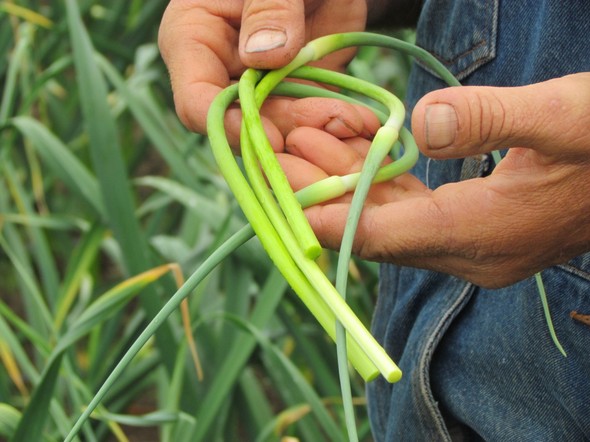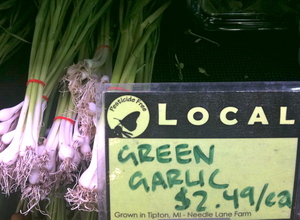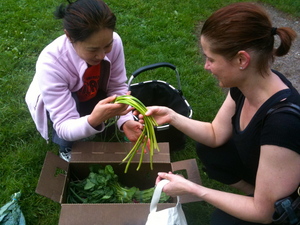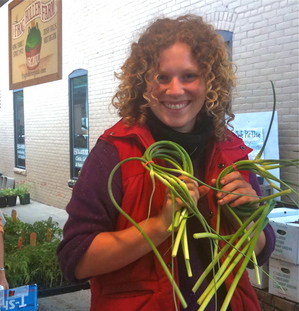The secret life of garlic: the great scapes

Richard Andres with garlic scapes at Tantre Farm in Chelsea
Photo from Deb Lentz, Tantre Farm
A few years ago this bizarre vegetable started showing up in our June CSA farm share box — long and green, almost as big around as an asparagus but with one end pointed like a tall papal mitre. Tasting of garlic, these, we learned, were garlic scapes.
The botanical definition of a scape is: "a leafless stalk in plants that arises from a rosette of leaves and bears one or more flowers." For example, a tulip is a scape.
In garlic, that tall stem with the conical hat turns into what Richard Andres of Tantre Farm says "is really an aerial bulb that will fall over, like a walking onion, and will re-sprout itself. If you don't take those off, you reduce your garlic bulb by about 30 percent."
So delicious garlic scapes are harvested as a way of ensuring that the underground bulb of the garlic plant will grow big and sturdy.
Diana Dyer, who with her husband Dick grows 42 varieties of "Dick's Pretty Good Garlic" at the Dyer Family Organic Farm, says when they harvest scapes "we are very careful about not injuring the top leaf (of the garlic plant), because we want all that solar energy being collected and going down into forming a large healthy, robust bulb."
Making sure that garlic bulbs will "size up" for the harvest starting in July means there are thousands of scapes to pull in June. Andres notes, "The interns say it's the funnest thing they thing they ever did — the funnest job ever — to tug on the scapes and try to get the longest scape you can. We have contests out in the field to to see who can get the longest stem before you break one. Katie got about 30 before she broke one."
There's a certain technique he describes, "You want to pull them very carefully, ease them out. First you pull, then release it, and pull again. They make a small groaning noise when they come out."
Angie Martin, a farmer at Frog Holler Organic Farm, says they have a special technique learned from Evan Dayringer, one of Tantre's farm staff. She says, "Evan showed us how, if you stick a pin in at the bottom of the scape, you can pull out about another six inches. Six inches! And it's the tenderest, sweetest part of the plant."
Green garlic at the People's Food Co-op
Kim Bayer | Contributor
Even before scapes comes the green garlic, which is harvested for the same reason — making sure that the main bulb is big and healthy. Richard Andres says that green garlic is "just a young garlic plant that has over-wintered and hasn't really formed a bulb yet, like a green onion."
According to Diana Dyer, "Green garlic is milder. and it's so pretty. You can use the whole thing — you can use the green tops, which add color and flavor. And it's the first garlic of the season. That's why chefs are crazy about it. We never even take it to market. Literally, chefs stand in line for it."
The Dyers may have sold out of their green garlic, but the People's Food Co-op recently had some on display from Needle-Lane Farm in Tipton, and Andres says he could bring some if anyone asked.
Like Tantre and Frog Holler Farms, the Dyers are now harvesting their garlic scapes as fast as they can. Diana Dyer says they plan to do tastings with scapes of their 42 garlic varieties at the three markets they'll be attending over the next several weeks in downtown Ypsilanti on Tuesdays, in Ann Arbor at the market on Wednesday evenings, and at the Westside Market on Thursdays.
She says their garlic varieties are "all different — just like peppers are different. Some are better in raw dishes like gazpacho or guacamole, some are better for stir frying or braising. The garlic-ness ranges everywhere from five-alarm to mild. We have to know how people want to use it and what kind of dish, and if they want their garlic-ness to take center stage or blend in with the orchestra."
Garlic does seem to be nearly as universal as music. According to the Kew Gardens website, after originating in central Asia, garlic "spread in ancient times to the Mediterranean region and beyond. It was used in Egypt by 3000 BC. It was also known by the advanced ancient civilisations of the Indus Valley, in what today is Pakistan and western India. From here it spread to China. The Spanish, Portuguese and French introduced it to the New World." I say thank you Spain, Portugal and France.
Garlic may be beloved across the planet, but after helping out with the Tantre Farm CSA distribution last week, what I observed is that garlic scapes are also beloved in the CSA world.
As 3-year-old Arthur Lopatin fed his mom Aubrey a raw scape, their friend (and wedding cake baker) Olivia May said, "Garlic scapes are my secret ingredient for everything — pesto, vinaigrette, egg dishes. A good spring thing is greens sauteed with scapes with an egg over easy on top."

Ge Zhang tells her friend, Kathryn Jacobi, about garlic scapes and how to use them at the Tantre Farm CSA pickup.
Contributor | Kim Bayer
Another Tantre member, Ge Zhang, says that she uses scapes for stir-frying and soups, but "stir-fried with tofu is the best."
And Anna Austin says she uses "a bed of scapes to roast with chicken. By the time you're done roasting, they're very soft. Just the flavor of the chicken is like rapture. It's like roasting on a bed of garlic without all the fuss of breaking apart and peeling all those garlic cloves."
Andres thinks garlic deserves its own festival — like the extravaganza out in Gilroy, Calif.
He says, "Garlic's season is whenever you're hungry. You can pull up a garlic plant any time in its life cycle and chop it up and eat it. If you planted enough garlic, then you don't feel too bad about pulling it up halfway through its lifecycle. You can never have too much. It's a very nice plant since there are not a huge amount of diseases. It stores pretty well. It's nice to have around — like a low-maintenance girlfriend. Or boyfriend… It's exactly what Les Blank says — Garlic is as good as 10 mothers."
Diana Dyer's Garlic Scape and Kale Pesto (from 365 Days of Kale)
http://www.365daysofkale.com/2010/07/recipe-garlic-scape-kale-pesto.html
Tantre Farm's Pickled Garlic Scapes (from Erin Dronen, Tantre intern, adapted from the Ball Blue Book dilly beans recipe)
2 pounds garlic scapes
1/4 cup canning salt
2-1/2 cups vinegar
2-1/2 cups water
1 teaspoon cayenne pepper, divided*
4 teaspoons dill seed, divided
*optional (I've also used one whole cayenne pepper per quart)
Trim flower pods off of the garlic scapes and chop so that they will fit in the jars (separating the straight sections of the scape from the curly sections makes it easier to fill the jars later).
Combine salt, vinegar and water in a large saucepot. Bring to a boil. Pack scapes (the straight sections pack quickly and easily; the curly pieces need a little encouragement, but are beautiful and just as delicious) into hot jars, leaving 1/4-inch headspace. Add 1/4 teaspoon cayenne pepper and one teaspoon dill seed to each pint. Ladle hot liquid over beans, leaving 1/2-inch headspace.
Remove air bubbles. Adjust two-piece caps. Process pints and quarts 10 minutes in a boiling-water canner.
Yield: about four pints/two quarts.
Kim Bayer is a freelance writer and culinary researcher.



Comments
Diana Dyer
Tue, Jun 14, 2011 : 1:59 a.m.
Kim, Thanks for telling everyone about beautiful, delicious, and versatile garlic scapes. We are growing 42 varieties of garlic at the Dyer Family Organic Farm in Superior Township, but as a very minor correction to your article, we 'only' have 30 hard-neck varieties of garlic, which are the ones that produce scapes. We'll be bringing these scapes (which have a wide range of flavors) to local farmers' markets over the next several weeks as they emerge, curl, and are ready to harvest (about one week later this year than 2010). Thanks again for highlighting Michigan produce!
Terri
Mon, Jun 13, 2011 : 8:12 p.m.
Love the title.